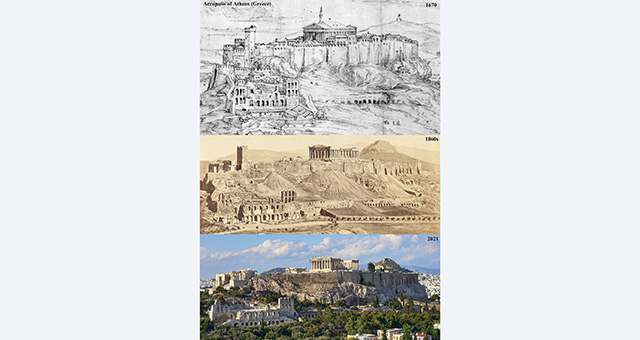The Acropolis Through the Ages: 1670 to 2021 – A Journey of Transformation
The Acropolis of Athens is not just the most iconic monument of Greece’s capital—it is a living testament to a civilization’s cultural legacy. Let’s take a brief journey through how the Acropolis looked and functioned in three different periods: 1670, 1860, and 2021, and how its transformation reflects the story of Greece itself.
1670: The Acropolis Under Ottoman Rule
In 1670, Greece was under Ottoman control. The Parthenon, the centerpiece of the Acropolis, had been converted into a mosque. A minaret was added, and the temple was used for Islamic worship. Though much of the structure remained intact, its classical character was gradually fading. The Acropolis during this era stood as a symbol of shifting powers and religious transformations.
1860: Archaeological Awakening in Independent Greece
After gaining independence in 1830, Greece began to reclaim and celebrate its ancient heritage. By 1860, archaeological excavations and conservation efforts were underway. Ottoman and Frankish additions to the Acropolis, including the mosque structures, were removed in an attempt to restore its ancient Greek form. This period marked the “purification” of the site, aiming to revive national identity through the rediscovery of classical antiquity.
2021: Modern Preservation and Controversy
Today, the Acropolis is a UNESCO World Heritage Site and one of the most visited archaeological landmarks in the world. Modern restoration projects focus on structural stability, marble reconstruction, and accessibility improvements, such as wheelchair-friendly pathways. However, some of these changes—particularly the use of modern materials—have sparked debates among historians and architects. Still, these efforts are vital for preserving the monument for future generations.
When a civilization leaves its mark over centuries on a single location, it becomes more than just stone—it becomes a living time machine. The Acropolis, therefore, does not merely speak of the past, but also looks toward the present and future.
Sources
UNESCO World Heritage Centre – Acropolis, Athens
British Museum – The Parthenon and Its History
Acropolis Restoration Service (YSMA), Greek Ministry of Culture
Official website with updates on restoration and preservation work.

